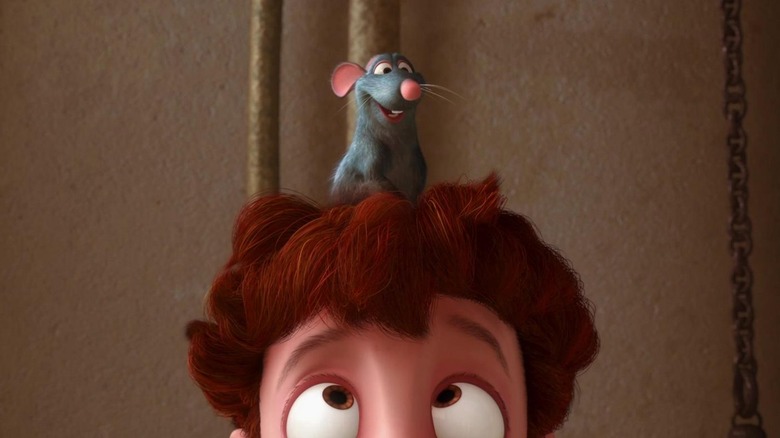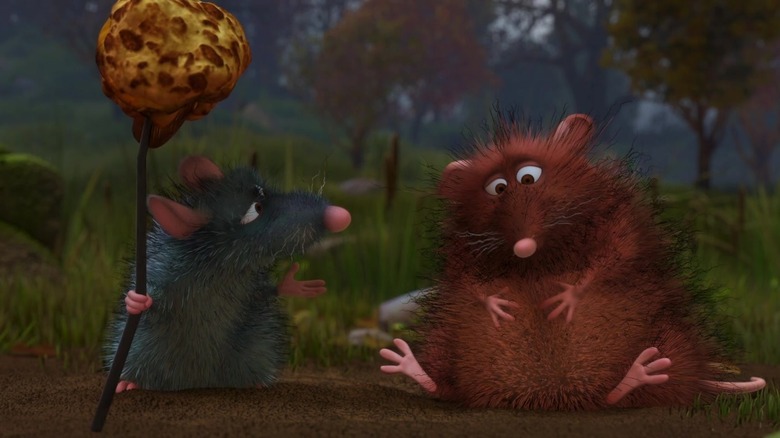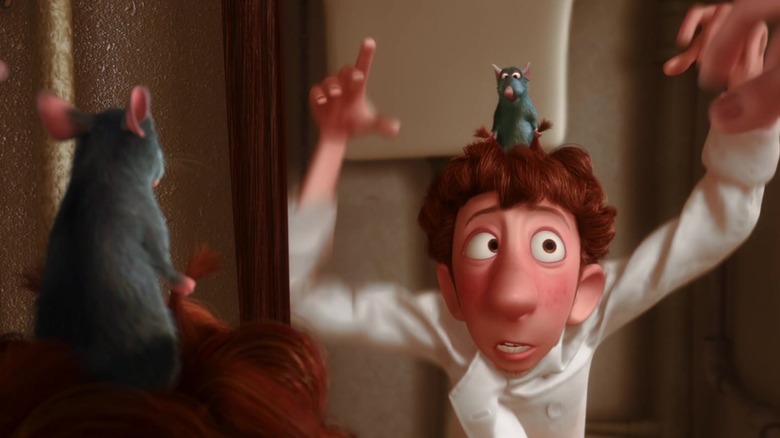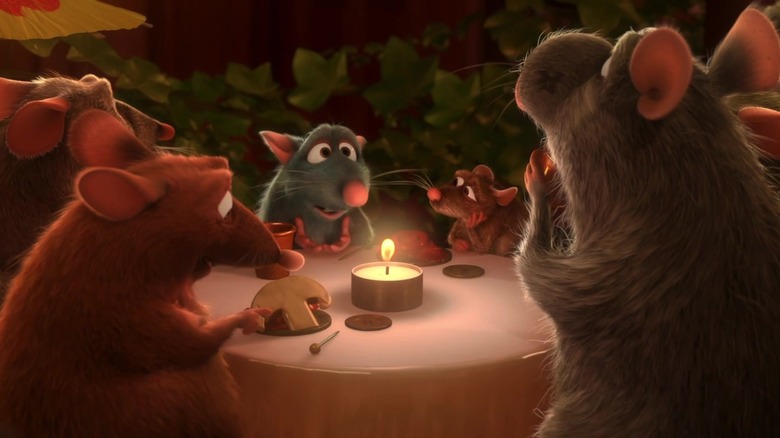Finishing Ratatouille Was A Frantic Race To The Finish
"Ratatouille" is a funny movie about a rat named Remy who controls a human cook named Linguini by pulling his hair. It is also a film about genius. Remy has it, Linguini lacks it but never resents it, his girlfriend Colette has it but is never recognized for it. The restaurant critic Anton Ego, who rises in the film's third act like a vengeful demon, is familiar enough with genius to despise its perpetual absence from everyday life. Remy's food brings not just nostalgia but the shock of recognition. Ego finds the one cook left in the world able to surprise him, Remy finds a critic who understands him completely.
It's exactly what you'd expect from Brad Bird, a filmmaker revered by animation veterans. His classic "The Iron Giant" told the story of an alien weapon of violence that must learn to use its powers responsibly. In his first film for Pixar, "The Incredibles," a family of superheroes are caged by societal restrictions that prevent them from being all they can be. "Ratatouille" is yet another tale of an artist who overcomes the world's ambivalence to become a recognized chef. These three films bear the mark of an auteur, a man who reimagined his own creative frustration as a robot, a superhero and then a rat. But this perception isn't entirely accurate, because Brad Bird did not create "Ratatouille." In fact, he came to the film to save it. Remy's real father, removed from the project by Pixar's "brain trust," was the animator Jan Pinkava.
The Czech style
Pinkava was born in Prague in 1963. While he applied to Pixar as a director of commercials, what he really wanted to do was to direct short films. He got his wish in 1997, when his short "Geri's Game" was released. "Geri's Game" was the first Pixar animation to focus solely on humans, with no talking objects or animals to be seen. Pinkava knew that to create a realistic human character within the technological limits of the time would be foolish. So he took inspiration from his Czech roots, drawing from the exaggerated style of animator and puppeteer Jiri Trnka according to a Cartoon Brew interview. There's a coldness to Geri's eyes that marks him as a creation of 1997. But his expressiveness was impressive for the time and remains entertaining today.
Pinkava worked hard to earn his place among the studio's founders, so he was given a film of his own to direct. He decided to make a movie about a rat who loved to cook, a risky idea that nevertheless fits perfectly within the Czech animation tradition. After years of production, Pinkava and his team had great concept art, character models and background work, but no movie. This is where Pinkava's troubles began, according to David A. Price's book "The Pixar Touch." Pinkava called for help, and the studio's old hand Bob Peterson came on board. What Pinkava never agreed to, but Pixar insisted upon, was that Peterson would be given exclusive control over the story. Peterson toiled away on the project, but he could not find an approach that satisfied head Pixar creatives like Lasseter and Stanton. Peterson eventually gave up, and Pinkava cut ties with the studio shortly after. "Ratatouille" had become a ghost ship.
A beautiful car, somehow not drivable
By choosing to direct "Ratatouille," Brad Bird made the call to take a bullet for his friends at Pixar. Bird believed in the work that Stanton and company were doing, and he saw his role on "Ratatouille" as an opportunity to pay it forward. But he also genuinely liked Jan Pinkava's concepts for "Ratatouille," even if he had his reservations about the overall narrative. According to Pinkava, in the aforementioned Cartoon Brew interview, Bird had joined Pixar to begin with because of his appreciation for "Geri's Game." Bird would tell Animation Art Conservation that his experience working on the film was like "a mechanic looking at a beautiful car that was somehow not drivable." All Bird had to do was to rebuild the decorative engine of "Ratatouille" into a working motor, and he would hopefully have a film worthy of Pinkava's ideas. They only had 18 months to do it.
Bird had past experience with tight turnarounds. His earlier work "The Iron Giant" was made in just two and a half years at Warner Bros. Feature Animation, on a significantly lower budget than would be allotted to a comparable Disney film. Before that, Bird worked in the trenches on "The Simpsons," as part of a generation of storyboarders who together expanded the show's repertoire of cinematic tricks. Rather than "maximizing the work and minimizing the number of shots," as was typical of the industry of the time, Bird's crew experimented in each episode and simply learned to draw fast enough that this was never a problem. As Bird would say, "You had to move and make decisions quickly. That saved my butt in all three [at the time] of the feature films I've done..."
Flowers for Remy
With "Ratatouille," Bird had the advantage that much of the legwork had already been done for him. Remy, Linguini and Anton Ego were all Pinkava's creations, with models already prepared. Bird built up the role of Colette, Linguini's terse girlfriend and ally in the kitchen, and turned the cook Gusteau into a ghost. Perhaps the most important change Bird made was streamlining Remy's character. In the hands of Pinkava and his team, Remy was trapped between his dreams of being a cook and his identity as a rat. By comparison, Bird's take on Remy never once doubts himself. The real challenge he faces is instead convincing others to take him seriously. In this way, "Ratatouille" was transformed from an appealing but messy design project into a straightforward, functional film.
"Ratatouille" remains one of the best-liked Pixar films, as well as fuel for one of the funniest scenes in "Everything Everywhere All at Once." Yet it is also a harbinger of the studio's future. In the following years, Pixar's brain trust would continue to excise directors from problematic studio projects, including Brenda Chapman ("Brave") and Bob Peterson ("The Good Dinosaur.") Folks like Lasseter would insist that these tough calls were made to produce better movies. Yet these decisions also served to alienate staff and homogenize the studio's output. Recent projects like "Turning Red" herald a promising new direction for the studio, yet are hamstrung by the relentless interference of the broader Disney company. If Pixar hopes to recapture its glory days, it needs a company culture capable of supporting not just the efficient storytelling of Brad Bird but the knotty creativity of Jan Pinkava. A race to the finish may spur creativity, but so may slowing down and taking the necessary time.



